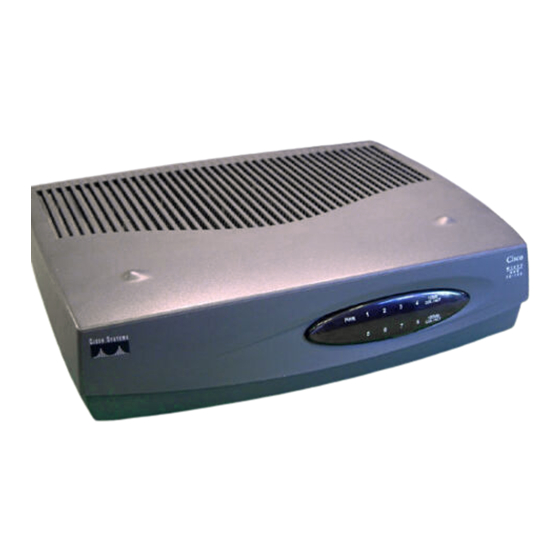Table of Contents
Advertisement
Quick Links
Overview
This chapter describes the features and components of the Cisco 1538 series Micro Hubs
10/100 (hereafter collectively referred to as the "Micro Hubs"). These class-II repeaters are
a part of the Cisco Networked Office stack, a family of stackable, desktop networking
platforms designed for small workgroups.
Overview of the Micro Hubs
The Micro Hubs are stackable, 8-port, 10/100-Mbps, autosensing Fast Ethernet class II
repeaters with internal bridging.
•
The Cisco 1538M Micro Hub 10/100 (hereafter referred to as the "managed hub") can
be monitored through a web console or the command-line interface. This hub can
manage a stack of up to 3 additional Micro Hubs and serve up to 32 user connections.
For an overview of the management features of this hub, see the "Management Options
(Cisco 1538M Hub)" section on page 1-7.
•
The Cisco 1538 Micro Hub 10/100 (hereafter referred to as the "manageable hub") is
without internal management applications but can be monitored and controlled through
interconnection to a managed hub.
Either hub model can be a standalone networking device or can connect to other routers,
switches, and hubs to form a larger network. You can also stack and connect up to four hubs
through the rear-panel ports to form a larger network.
C H A P T E R
Overview 1-1
1
Advertisement
Table of Contents

Subscribe to Our Youtube Channel
Summary of Contents for Cisco 1538 series
- Page 1 C H A P T E R Overview This chapter describes the features and components of the Cisco 1538 series Micro Hubs 10/100 (hereafter collectively referred to as the “Micro Hubs”). These class-II repeaters are a part of the Cisco Networked Office stack, a family of stackable, desktop networking platforms designed for small workgroups.
- Page 2 — The Cisco ConfigMaker configuration application provides a single configuration interface for all products in the Cisco Networked Office stack. — Cisco 1538 Hub Manager with an embedded HTTP server provides an interface for all supported management functions. — A command-line interface (CLI) supports management through Telnet in-band or console port out-of-band connections.
-
Page 3: Front Panel Leds
Front-Panel LEDs Front-Panel LEDs This section describes the hub front-panel LEDs. Figure 1-1 Front-Panel LEDs Solid green—Micro Hub has power. Blinking amber—Hub detects Solid amber—POST in progress. collisions on the network. The LED After power-on—POST nonfatal failure. blinks faster as more collisions occur. With blinking port LED—POST fatal failure. -
Page 4: Rear Panel Components
Rear-Panel Components Rear-Panel Components Figure 1-2 shows the rear-panel ports, connectors, and LEDs for the Cisco 1538M and Cisco 1538 Micro Hubs. Figure 1-2 Rear-Panel LEDs and Components of the Cisco 1538M Managed Hub Power receptacle Lock Connect power cord slot to this receptacle. - Page 5 Rear-Panel Components Figure 1-3 Rear-panel Components of the Cisco 1538 Manageable Hub Power receptacle Lock Connect power cord slot to this receptacle. 10/100 Cisco 1538 SPEED 100BaseTX 10BaseTX 2 3 4 RATING DOWN 5 6 7 8 100-127 /200-240 V~ 0.3A / 0.2 50/60 Hz...
-
Page 6: Stack Management
RATING DOWN 100-127 /200-240 V~ 0.3A / 0.2 50/60 Hz MDI -X MDI-X For more information about stacking Micro Hubs, see “Installing Micro Hubs in a Stack” on page 2-8. Cisco 1538 Series Micro Hub 10/100 Installation and Configuration Guide... - Page 7 Management Options (Cisco 1538M Hub) Management Options (Cisco 1538M Hub) The Cisco 1538M hub can manage a single hub or a hub stack. You can use the default settings shipped with the hub, or you can customize the configuration through the Cisco 1538 Hub Manager web-based interface, the CLI, or SNMP.
-
Page 8: Default Configuration Settings
System Configuration Page For procedures on how to reset all hub console port settings to the factory defaults, see the “Resetting the Hub to the Factory Defaults” section on page 4-14. Cisco 1538 Series Micro Hub 10/100 Installation and Configuration Guide... - Page 9 Overview of the Cisco 1538 Hub Manager Overview of the Cisco 1538 Hub Manager The Cisco 1538 Hub Manager (hereafter referred to as the hub manager) is a web-based graphical user interface for basic hub configuration and monitoring. Using the hub manager, you can configure and monitor the hub from anywhere on your intranet.
-
Page 10: Overview Of The Command-Line Interface
CLI and SNMP. Procedures describing how to access the CLI are in the “Accessing the CLI” section on page 2-29. For complete information about using the CLI, refer to the Cisco 1538 Series Micro Hub 10/100 Command Reference. 1-10... -
Page 11: Overview Of Snmp
Overview of SNMP Overview of SNMP You can configure and monitor the hub by accessing the Management Information Base (MIB) variables through Simple Network Management Protocol (SNMP), an application-layer protocol facilitating the exchange of management information between network devices. The hub supports a comprehensive set of MIB objects, including four Remote Monitoring (RMON) groups. - Page 12 Send an unsolicited message from an SNMP agent to an SNMP manager indicating that some event has occurred. An SNMP manager does not need the exact variable name. It sequentially searches to find the needed variable from within a table. 1-12 Cisco 1538 Series Micro Hub 10/100 Installation and Configuration Guide...









Need help?
Do you have a question about the 1538 series and is the answer not in the manual?
Questions and answers